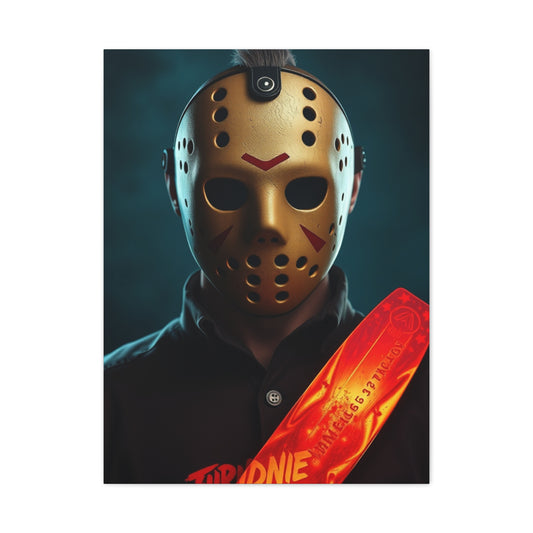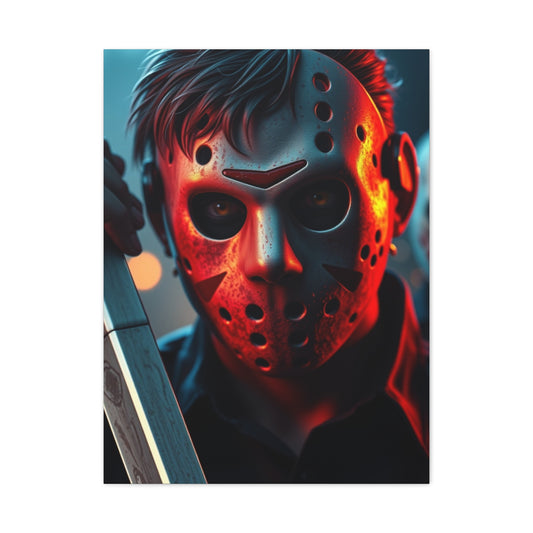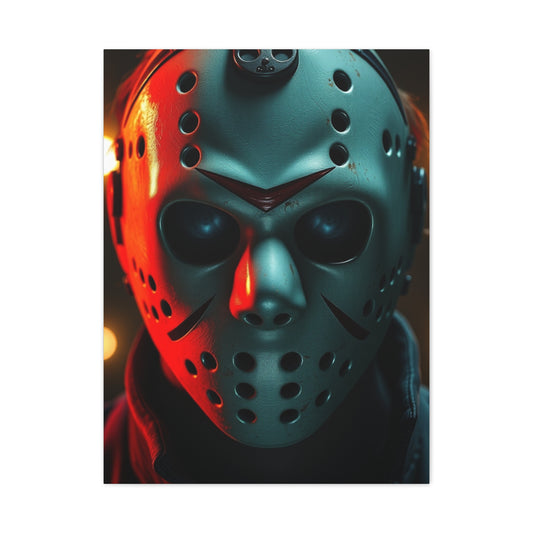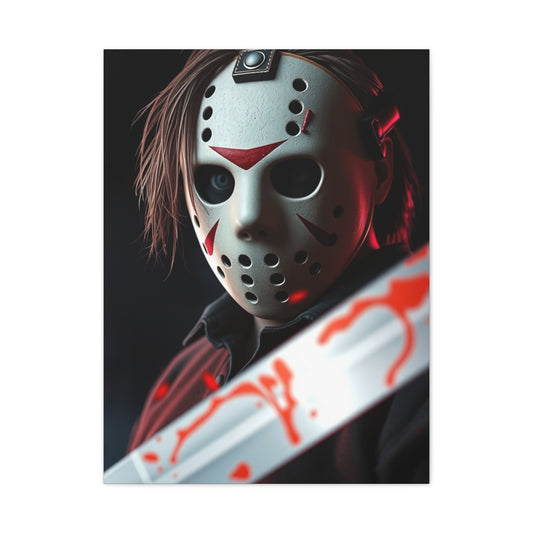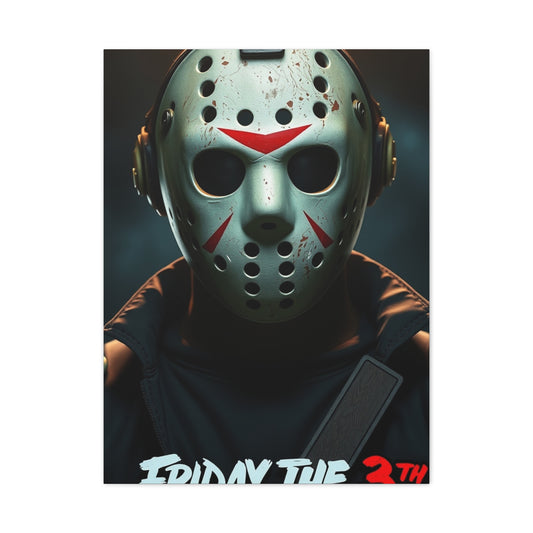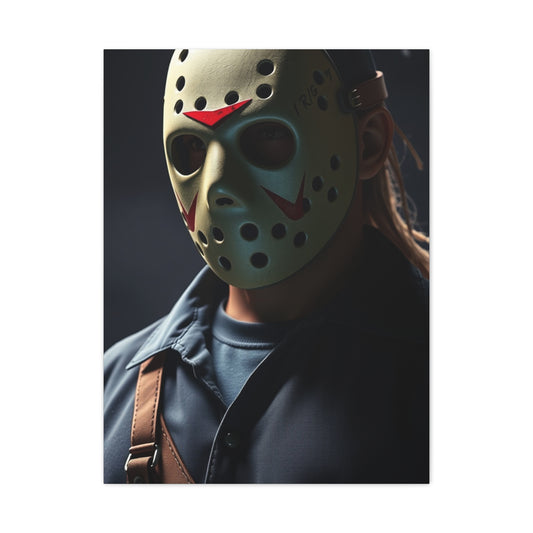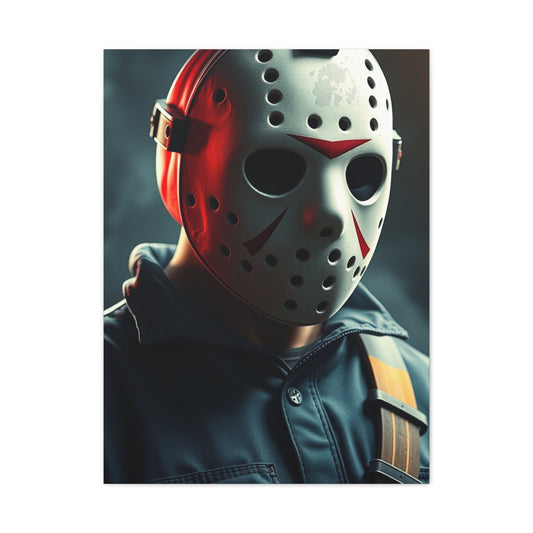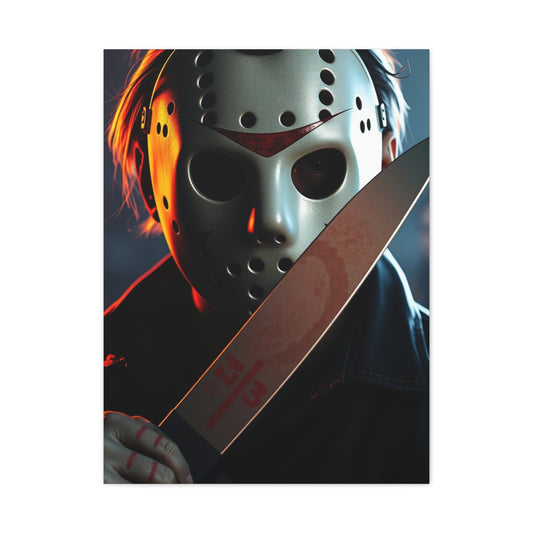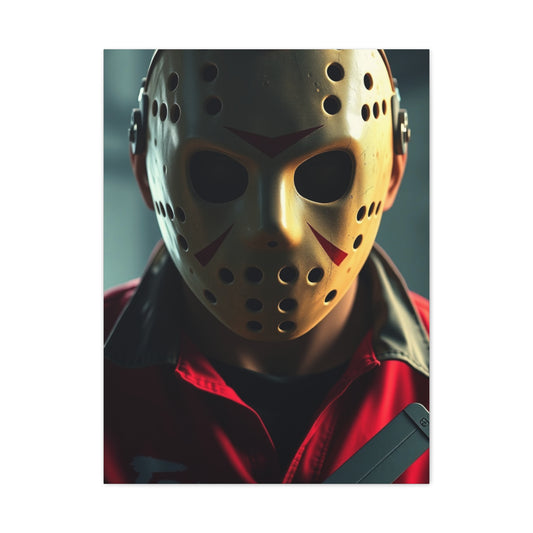Friday the 13th Characters Wall Art: Bring Iconic Horror Legends to Your Walls
The fascination with macabre aesthetics has transcended traditional boundaries, establishing itself as a sophisticated form of artistic expression within contemporary interior design. Horror wall art represents more than mere decoration; it embodies a cultural phenomenon that celebrates the darker aspects of human imagination while paying homage to cinematic masterpieces that have shaped our collective consciousness.
The psychological appeal of incorporating frightening imagery into living spaces stems from humanity's complex relationship with fear and the unknown. These artistic representations allow individuals to confront their deepest anxieties within a controlled environment, transforming potentially threatening imagery into objects of beauty and contemplation. The juxtaposition of terror and artistry creates a compelling visual narrative that challenges conventional decorating norms while establishing a unique personal statement.
Modern collectors and enthusiasts gravitate toward these distinctive pieces because they represent rebellion against mainstream decorative trends. The sophistication required to appreciate horror aesthetics demonstrates intellectual depth and cultural awareness, particularly when the artwork references iconic characters and scenes from beloved franchise films. This form of artistic expression celebrates the craftsmanship of legendary filmmakers, practical effects artists, and character designers who created enduring images of terror.
The evolution of horror wall art reflects broader cultural shifts in how society processes trauma, mortality, and existential dread. Rather than avoiding these uncomfortable topics, contemporary audiences embrace them through artistic mediums that transform fear into fascinating visual experiences. This transformation allows viewers to engage with complex emotions while maintaining psychological distance through the medium of art.
The Cultural Significance of Slasher Film Aesthetics
Slasher cinema emerged as a dominant force in horror entertainment during the late twentieth century, establishing visual languages that continue to influence artistic expression decades later. These films created archetypal imagery that transcends their original medium, becoming symbols recognized across global cultures. The iconic masks, weapons, and silhouettes associated with legendary characters have achieved mythological status within popular culture.
The artistic interpretation of slasher imagery requires careful consideration of visual elements that made these characters so memorable. Successful horror wall art captures the essence of terror without relying solely on gore or explicit violence. Instead, the most compelling pieces focus on atmospheric tension, symbolic representation, and the psychological impact of suggestion rather than graphic depiction.
Contemporary artists working within this genre demonstrate remarkable creativity in reimagining familiar characters through fresh artistic lenses. They experiment with color palettes that evoke specific emotional responses, employ compositional techniques that create visual unease, and utilize texture variations that enhance the tactile experience of viewing the artwork. These approaches transform simple character portraits into complex artistic statements.
The commercial success of horror-themed wall art reflects broader entertainment industry trends that celebrate nostalgic properties while introducing them to new generations. Collectors appreciate the dual nature of these pieces, which function simultaneously as artistic objects and cultural artifacts that preserve important moments in cinematic history. This preservation aspect adds significant value to well-executed horror wall art collections.
Understanding Canvas Print Quality
The technical aspects of producing high-quality horror wall art significantly impact the final product's visual impact and longevity. Canvas printing technology has evolved dramatically in recent years, allowing for unprecedented detail reproduction and color accuracy that brings terrifying characters to life with stunning clarity. Understanding these technical elements helps collectors make informed purchasing decisions.
Professional-grade canvas materials provide superior durability compared to standard paper prints, ensuring that horror wall art maintains its visual impact for decades. The texture of quality canvas adds dimensional depth to printed images, creating subtle variations in light reflection that enhance the atmospheric qualities essential to effective horror imagery. These textural elements contribute to the immersive experience that makes horror wall art so compelling.
Color reproduction accuracy becomes particularly crucial when dealing with horror aesthetics, where specific color palettes create emotional responses. Deep blacks must remain truly black rather than fading to gray, while subtle color gradations in shadowed areas need preservation to maintain the mysterious atmosphere that defines quality horror artwork. Premium printing processes ensure these critical elements remain intact throughout the artwork's lifespan.
The stretching and mounting process requires specialized techniques to prevent distortion of horror imagery, particularly when dealing with character masks or faces where proportional accuracy is essential. Professional mounting services understand the importance of maintaining perfect alignment and tension across the entire canvas surface, preventing the sagging or warping that could compromise the artwork's visual impact.
Protective coatings applied to finished canvas prints provide resistance against environmental factors that could degrade horror wall art over time. These treatments protect against ultraviolet light exposure, moisture damage, and atmospheric pollutants while maintaining the original color vibrancy that makes horror artwork so visually striking. Quality protective treatments remain invisible while providing long-term preservation benefits.
Exploring Iconic Character Representations
The pantheon of legendary horror characters provides endless inspiration for wall art creation, with each iconic figure offering unique visual elements that translate beautifully into artistic mediums. These characters possess instantly recognizable silhouettes and distinctive features that make them perfect subjects for artistic interpretation across various styles and approaches.
Character mask designs represent some of the most compelling elements in horror wall art, combining practical functionality with symbolic meaning that resonates deeply with audiences. The stark simplicity of certain masks contrasts beautifully with their psychological complexity, creating visual tension that skilled artists can exploit to create powerful artistic statements. These masks function as blank canvases upon which viewers project their own fears and interpretations.
Weapon imagery associated with legendary characters adds another layer of symbolic meaning to horror wall art. These implements of terror become artistic elements that suggest narrative potential while maintaining aesthetic appeal. Skilled artists incorporate these elements thoughtfully, using them to enhance composition rather than overwhelm the viewer with gratuitous violence or gore.
Environmental elements from iconic scenes provide contextual richness that elevates character-focused horror wall art beyond simple portrait work. Incorporating recognizable locations, atmospheric conditions, and symbolic objects creates immersive compositions that transport viewers into the fictional worlds these characters inhabit. This contextual approach demonstrates artistic sophistication while honoring the source material's narrative complexity.
The evolution of character design across multiple film installments offers artists opportunities to explore different interpretations of the same basic concept. This evolution provides rich source material for artistic exploration, allowing creators to reference multiple versions while developing their own unique vision. The most successful horror wall art finds ways to honor tradition while introducing fresh perspectives that keep familiar characters feeling contemporary and relevant.
Atmospheric Design Elements in Horror Wall Art
Creating effective horror wall art requires mastery of atmospheric elements that establish mood and emotional response before viewers even identify specific characters or narrative elements. These atmospheric components work subconsciously to prepare audiences for the psychological impact of the primary imagery, making them essential components of successful horror aesthetics.
Lighting effects play crucial roles in establishing the ominous atmosphere that defines quality horror wall art. The interplay between light and shadow creates depth, mystery, and visual tension that draws viewers into the artwork's emotional landscape. Strategic use of highlighting and shadowing can transform ordinary imagery into compelling visual narratives that suggest stories beyond what is explicitly depicted.
Color temperature manipulation allows artists to create specific emotional responses through careful palette selection. Cool blues and grays suggest coldness, isolation, and death, while warm reds and oranges can evoke blood, fire, and passion. The most sophisticated horror wall art employs complex color relationships that create emotional complexity rather than relying on obvious color associations.
Texture variations within horror wall art add tactile dimensions that enhance the viewing experience. Rough surfaces suggest decay and deterioration, while smooth areas might represent the cold perfection of death masks or metallic weapons. These textural contrasts create visual interest while supporting the psychological themes that make horror artwork so compelling.
Compositional techniques borrowed from cinematography translate beautifully into static wall art, allowing artists to create dramatic focal points and guide viewer attention through carefully planned visual pathways. These techniques include strategic use of negative space, diagonal compositions that create visual tension, and framing devices that isolate important elements while maintaining overall compositional balance.
Friday the 13th: A Cultural Phenomenon in Art
The Friday the 13th franchise represents one of horror cinema's most enduring legacies, providing rich source material for artistic interpretation that continues to inspire creators decades after the original film's release. The visual iconography associated with this franchise has achieved mythological status, making it perfect subject matter for sophisticated wall art collections.
Camp Crystal Lake provides a distinctive environmental backdrop that artists can reference to create atmospheric compositions that immediately establish narrative context. The juxtaposition of natural beauty with lurking menace creates compelling visual tension that skilled artists exploit to create powerful emotional responses. These environmental elements allow for artistic interpretation that goes beyond simple character portraits.
The evolution of the central antagonist's appearance across multiple film installments provides artists with diverse visual references to explore. From the early mysterious presence to the fully developed iconic appearance, this character progression offers opportunities for artistic interpretation that can reference specific film moments while maintaining broad appeal to franchise enthusiasts.
Symbolic elements associated with the franchise extend beyond the obvious character imagery to include environmental details, weapon choices, and atmospheric conditions that create rich compositional possibilities. These symbolic elements allow artists to create subtle references that knowledgeable viewers will appreciate while maintaining accessibility for general audiences who simply appreciate quality horror aesthetics.
The cultural impact of Friday the 13th extends far beyond its original cinematic context, influencing fashion, music, literature, and visual arts in ways that continue to evolve. Wall art celebrating this franchise participates in this broader cultural conversation, allowing collectors to engage with these themes through sophisticated artistic mediums that honor the source material while establishing independent artistic merit.
Character Development Through Visual Art
Horror wall art provides unique opportunities to explore character development through visual mediums that capture personality traits, emotional states, and psychological complexity in ways that complement narrative storytelling. These artistic interpretations can reveal character aspects that might not be immediately apparent in their original cinematic contexts.
Mask imagery functions as powerful symbolic representation that allows artists to explore themes of hidden identity, psychological transformation, and the relationship between public persona and private reality. The stark simplicity of horror masks contrasts with their psychological complexity, creating visual tension that skilled artists can exploit to create thought-provoking artistic statements.
Body language and posture communicate character traits without requiring explicit narrative context, allowing horror wall art to suggest personality characteristics through purely visual means. The way characters hold weapons, position their bodies, or interact with environmental elements can convey aggression, patience, cunning, or other psychological traits that add depth to artistic interpretation.
Environmental interaction reveals character relationships with their surroundings, suggesting whether they belong to specific locations or intrude upon them as foreign elements. These environmental relationships can communicate important character information while providing compositional opportunities that enhance the overall artistic impact of horror wall art pieces.
Character evolution across multiple artistic interpretations allows viewers to observe how different artists perceive the same basic character concepts. This diversity of interpretation enriches the overall cultural understanding of these iconic figures while demonstrating the flexibility of horror imagery to support various artistic visions and personal interpretations.
Horror Wall Art Display
Proper display techniques significantly impact the effectiveness of horror wall art, with lighting, positioning, and environmental factors all contributing to the overall viewer experience. Understanding these technical considerations helps collectors maximize the impact of their horror art investments while ensuring long-term preservation.
Lighting design requires careful consideration to maintain the atmospheric qualities that make horror wall art effective. Harsh, direct lighting can eliminate the subtle shadows and tonal variations that create mysterious atmosphere, while insufficient lighting might obscure important details that contribute to the artwork's emotional impact. The ideal lighting solution balances visibility with atmospheric preservation.
Wall positioning affects how viewers encounter horror wall art, with placement height, viewing angles, and surrounding elements all influencing the psychological impact of the artwork. Strategic positioning can enhance the surprise factor that makes horror imagery effective, while poor placement might diminish the artwork's emotional resonance or create awkward viewing experiences.
Environmental factors including humidity, temperature fluctuations, and air quality can significantly impact the longevity of horror wall art, particularly canvas prints that are sensitive to environmental changes. Proper environmental control protects artistic investments while maintaining the visual quality that makes horror wall art so appealing to collectors and enthusiasts.
Grouping strategies for multiple horror wall art pieces require careful consideration of visual relationships between individual artworks. Successful groupings create cohesive visual narratives while avoiding overwhelming viewers with excessive horror imagery. The most effective displays balance impact with sophistication, creating compelling visual experiences that demonstrate artistic appreciation rather than simple shock value.
The Psychology of Fear in Artistic Expression
Understanding the psychological mechanisms that make horror imagery compelling helps explain why horror wall art has become such a popular form of artistic expression. The human relationship with fear involves complex emotional responses that skilled artists can manipulate to create powerful viewing experiences that go far beyond simple shock or revulsion.
Controlled fear experiences allow individuals to confront anxiety-provoking imagery within safe environments where they maintain complete control over their exposure. Horror wall art provides opportunities for these controlled encounters with frightening imagery, allowing viewers to explore their emotional responses while maintaining psychological safety through the medium of art.
Cathartic release through horror imagery can provide psychological benefits that explain the therapeutic appeal of well-designed horror wall art. By confronting fears through artistic mediums, viewers may experience emotional relief and psychological resolution that contributes to overall mental health and emotional well-being.
Social bonding opportunities arise when horror wall art becomes a conversation starter that allows individuals to share their fears, preferences, and interpretations with others. These shared experiences create connections between people who appreciate the sophisticated artistry required to transform frightening imagery into compelling visual experiences.
Cultural processing of collective anxieties finds expression through horror imagery that addresses societal fears and concerns through symbolic representation. Horror wall art can serve as a form of cultural commentary that helps individuals process complex social issues while maintaining the psychological distance necessary for objective analysis.
Horror Wall Art Creation
The creation of effective horror wall art requires mastery of numerous artistic techniques that work together to produce compelling visual experiences. Understanding these techniques helps collectors appreciate the skill and creativity that goes into producing high-quality horror artwork while making informed decisions about their artistic investments.
Contrast manipulation serves as a fundamental tool for creating the dramatic visual impact that defines quality horror wall art. The strategic use of extreme light and dark areas creates depth, mystery, and visual tension that draws viewers into the artwork's emotional landscape. These contrast relationships can suggest narrative elements while maintaining purely abstract artistic appeal.
Color theory application in horror contexts requires sophisticated understanding of how different colors interact to create specific emotional responses. While obvious color choices like red for blood or black for death have their place, the most compelling horror wall art employs complex color relationships that create emotional nuance rather than relying on simple associations.
Compositional strategies borrowed from classical art traditions can enhance horror imagery by creating visual stability that contrasts with the unsettling subject matter. This juxtaposition between formal artistic structure and disturbing content creates psychological tension that makes horror wall art more intellectually engaging than simple shock imagery.
Texture application techniques add dimensional qualities that enhance the tactile appeal of horror wall art while supporting the atmospheric elements that make these pieces so compelling. Strategic texture variations can suggest different materials, environmental conditions, or emotional states that contribute to the overall narrative impact of the artwork.
Detail management requires careful balance between providing enough visual information to engage viewers while maintaining the mystery and suggestion that makes horror imagery psychologically effective. The most successful horror wall art provides rich detail in some areas while leaving others deliberately ambiguous, allowing viewers to participate in the creative process through their own imagination.
Collecting and Curating Horror Wall Art
Building a sophisticated horror wall art collection requires knowledge, patience, and discriminating taste that goes beyond simple enthusiasm for frightening imagery. Successful collectors understand the importance of artistic quality, cultural significance, and investment potential when making acquisition decisions.
Artist research helps collectors identify creators whose work demonstrates consistent quality and artistic vision that aligns with their collecting goals. Understanding an artist's background, technique, and artistic philosophy provides context that enhances appreciation while helping predict future value and cultural significance.
Quality assessment requires technical knowledge about printing processes, materials, and construction techniques that affect both visual impact and longevity. Collectors who understand these technical aspects can make informed decisions that protect their investments while ensuring optimal display quality for years to come.
Thematic coherence in horror wall art collections creates visual narratives that enhance the impact of individual pieces while demonstrating sophisticated curatorial vision. Collections that tell stories or explore specific themes through multiple artworks create more compelling viewing experiences than random assemblages of unrelated pieces.
Investment considerations include factors like edition sizes, artist reputation, cultural significance, and market trends that affect the long-term value of horror wall art collections. While artistic appreciation should remain the primary motivation for collecting, understanding these market factors helps collectors make decisions that protect their financial investments.
Display planning requires consideration of available space, lighting conditions, and viewing patterns that affect how horror wall art collections are experienced. Successful collectors plan their displays to maximize visual impact while creating comfortable viewing experiences that encourage contemplation rather than overwhelming viewers with excessive stimulation.
The Intersection of Horror and High Art
The boundaries between popular culture and fine art continue to blur, with horror imagery finding acceptance in galleries and museums that previously dismissed such subjects as beneath serious artistic consideration. This cultural shift reflects broader changes in how society values different forms of artistic expression while acknowledging the sophisticated skill required to create effective horror wall art.
Academic recognition of horror aesthetics has grown significantly in recent years, with scholars exploring the psychological, sociological, and artistic dimensions of frightening imagery. This academic interest validates the intellectual complexity of horror wall art while providing theoretical frameworks that enhance appreciation and understanding.
Gallery exhibitions featuring horror-themed artwork demonstrate the growing cultural acceptance of these subjects within fine art contexts. These exhibitions provide opportunities for artists working in horror genres to reach broader audiences while establishing critical credentials that enhance their artistic reputations and market positions.
Critical analysis of horror wall art employs the same sophisticated analytical tools used to evaluate more traditional artistic subjects, examining composition, color theory, symbolic content, and cultural significance. This critical attention validates horror wall art as a legitimate artistic pursuit worthy of serious consideration and analysis.
Cross-pollination between horror and other artistic genres creates innovative hybrid forms that expand the possibilities for artistic expression while challenging traditional categorical boundaries. These experimental approaches demonstrate the flexibility and adaptability of horror imagery to support diverse artistic visions and creative exploration.
Contemporary Trends in Horror Wall Art
Current trends in horror wall art reflect broader cultural movements while responding to technological advances that expand creative possibilities. Understanding these trends helps collectors and enthusiasts appreciate how contemporary artists are reimagining traditional horror imagery for modern audiences.
Digital art integration allows for unprecedented detail and color accuracy in horror wall art while enabling artistic effects that would be impossible with traditional mediums. These technological capabilities create opportunities for innovative artistic approaches that push the boundaries of what horror wall art can achieve visually and emotionally.
Minimalist interpretations of horror imagery demonstrate how powerful suggestion can be more effective than explicit depiction in creating psychological impact. These simplified approaches rely on viewer imagination to complete the artistic narrative, creating more engaging and personally meaningful viewing experiences.
Mixed media approaches combine traditional and contemporary techniques to create horror wall art that incorporates multiple artistic elements and textural variations. These hybrid techniques allow artists to create unique pieces that stand out in increasingly crowded markets while offering collectors truly distinctive artworks.
Cultural fusion brings together horror imagery from different cultural traditions to create artworks that speak to global audiences while honoring diverse artistic heritage. These cross-cultural approaches expand the visual vocabulary available to horror artists while creating opportunities for cultural dialogue and understanding.
Sustainability concerns influence material choices and production methods in contemporary horror wall art, with environmentally conscious artists seeking ways to reduce their environmental impact without compromising artistic quality. These sustainable approaches appeal to collectors who value environmental responsibility alongside artistic excellence.
The Role of Nostalgia in Horror Art Appreciation
Nostalgia plays a significant role in the appeal of horror wall art, particularly pieces that reference classic films and characters from earlier decades. This nostalgic element adds emotional depth to the viewing experience while connecting contemporary audiences with important moments in cultural history.
Childhood memories of encountering horror imagery create powerful emotional associations that enhance the appeal of related wall art in adult contexts. These early experiences with frightening imagery often involve complex emotions including fear, excitement, and fascination that make horror wall art particularly resonant for many collectors.
Generational connections form when horror wall art helps bridge gaps between different age groups who share appreciation for classic horror imagery. Parents who grew up with certain horror franchises can share these experiences with their children through sophisticated artistic interpretations that make the material accessible to new generations.
Cultural preservation occurs when horror wall art documents and celebrates important moments in entertainment history that might otherwise be forgotten or overlooked. These artistic interpretations serve as cultural artifacts that maintain connections to significant creative achievements while making them accessible to contemporary audiences.
Temporal distance allows viewers to appreciate artistic and technical achievements in classic horror films without the immediate fear response that might have accompanied their original viewing. This temporal buffer enables more objective artistic appreciation while maintaining emotional connection to the source material.
Event-Based Display Strategies
Horror wall art offers unique opportunities for seasonal and event-based displays that can transform living spaces according to calendar cycles and special occasions. These rotating display strategies keep collections feeling fresh while maximizing the impact of individual pieces through strategic timing.
Halloween preparations provide natural opportunities to feature horror wall art prominently, creating immersive environments that celebrate the season while showcasing artistic collections. These seasonal displays can transform ordinary spaces into atmospheric environments that enhance holiday celebrations while demonstrating sophisticated artistic taste.
Year-round integration requires careful consideration of how horror wall art functions within everyday living spaces, balancing artistic impact with domestic comfort. Successful year-round displays demonstrate how quality horror artwork can enhance rather than overwhelm residential environments when properly selected and positioned.
Special event displays for movie releases, anniversaries, or cultural celebrations provide opportunities to highlight specific pieces or themes within horror wall art collections. These focused displays can create educational opportunities while generating renewed interest in familiar artworks through fresh contextual presentations.
Rotating exhibitions within private collections keep displays feeling dynamic while ensuring that all collected pieces receive appropriate attention and appreciation. These rotation strategies prevent viewer fatigue while maximizing the investment value of comprehensive horror wall art collections.
Atmospheric enhancement through coordinated lighting, music, and environmental elements can transform horror wall art displays into immersive experiences that engage multiple senses. These enhanced presentations demonstrate the full potential of horror artwork to create compelling environmental experiences that go far beyond simple wall decoration.
Future of Horror Wall Art
The future of horror wall art appears bright, with technological advances, cultural shifts, and artistic innovation combining to create new possibilities for creative expression within this genre. Understanding these emerging trends helps collectors and artists prepare for future developments while making informed decisions about current investments and creative directions.
Technological integration will continue expanding the possibilities for horror wall art creation and display, with advances in printing technology, interactive elements, and digital integration creating unprecedented opportunities for artistic innovation. These technological capabilities will enable new forms of viewer engagement while maintaining the fundamental appeal of horror aesthetics.
Virtual and augmented reality applications may transform how horror wall art is experienced, allowing viewers to interact with artwork in ways that were previously impossible. These technological enhancements could create immersive experiences that blur the boundaries between static art and dynamic entertainment while preserving the contemplative aspects that make wall art so appealing.
Global cultural exchange will continue enriching the visual vocabulary available to horror artists, bringing together imagery and techniques from diverse cultural traditions to create innovative hybrid forms. This cross-cultural pollination will expand the possibilities for artistic expression while creating opportunities for cultural dialogue and understanding.
Environmental consciousness will increasingly influence material choices and production methods in horror wall art, with sustainable practices becoming standard rather than exceptional. These environmental considerations will drive innovation in production techniques while appealing to environmentally conscious collectors who value sustainability alongside artistic excellence.
Market expansion into new demographic segments will continue growing the audience for horror wall art, with changing cultural attitudes and artistic recognition bringing these works to broader audiences. This market growth will support more artists working in horror genres while increasing the cultural significance and investment potential of quality horror artwork.
Preservation of Horror Wall Art
Proper maintenance and preservation techniques ensure that horror wall art collections maintain their visual impact and investment value for decades to come. Understanding these preservation principles helps collectors protect their artistic investments while ensuring optimal display quality throughout the artwork's lifespan.
Environmental control represents the most critical factor in preserving horror wall art, with temperature stability, humidity management, and air quality all affecting the longevity of canvas prints and other artistic mediums. Proper environmental conditions prevent deterioration while maintaining the color accuracy and structural integrity that make horror artwork visually compelling.
Cleaning protocols for horror wall art require gentle techniques that remove accumulated dust and pollutants without damaging delicate printing or surface treatments. Understanding appropriate cleaning methods and frequencies helps maintain artwork appearance while avoiding damage that could compromise visual quality or investment value.
Damage assessment and repair require professional expertise to ensure that any necessary restoration work maintains the integrity of original artistic intent while addressing structural or cosmetic issues. Early identification and professional treatment of damage prevent minor problems from becoming major restoration challenges that could significantly impact artwork value.
Insurance considerations for horror wall art collections include documentation, valuation, and coverage options that protect against various forms of loss or damage. Proper insurance planning provides financial protection while encouraging collectors to maintain detailed records that support both insurance claims and investment tracking.
Storage solutions for rotating displays or temporarily unused pieces require appropriate materials and environmental conditions that prevent damage during storage periods. Quality storage practices ensure that all collection pieces remain in optimal condition regardless of their current display status.
Investment Potential and Market Dynamics
The horror wall art market demonstrates increasing sophistication and investment potential as cultural attitudes toward these subjects continue evolving. Understanding market dynamics helps collectors make informed decisions while participating in a growing cultural movement that celebrates sophisticated artistic interpretations of frightening imagery.
Market trends indicate growing acceptance of horror themes within fine art contexts, with galleries, museums, and collectors increasingly recognizing the artistic merit of well-executed horror wall art. This cultural shift creates opportunities for significant value appreciation in quality pieces while expanding the potential audience for these artistic works.
Artist recognition plays a crucial role in determining investment potential, with established creators commanding higher prices while emerging artists offer opportunities for growth investments. Understanding artist trajectories and market positioning helps collectors identify pieces with strong appreciation potential while supporting artistic careers.
Edition sizes and rarity factors significantly influence the investment potential of horror wall art, with limited editions and unique pieces generally commanding higher values than mass-produced alternatives. These scarcity factors create artificial demand that can drive significant value appreciation in quality pieces over time.
Cultural significance affects long-term investment potential, with artwork that captures important cultural moments or references enduring creative works demonstrating stronger appreciation potential than pieces with purely contemporary appeal. Understanding cultural context helps collectors identify pieces with lasting significance that transcends temporary trends.
Market liquidity considerations include the availability of secondary markets, auction venues, and specialized dealers who facilitate buying and selling activities within the horror wall art community. Strong secondary markets provide confidence for collectors while ensuring that investments remain accessible for portfolio management purposes.
Creating Immersive Horror Environments
Horror wall art can serve as the foundation for creating immersive environmental experiences that transform living spaces into atmospheric settings that celebrate horror aesthetics while maintaining residential comfort and functionality. These comprehensive design approaches demonstrate the full potential of horror artwork to influence spatial experience.
Lighting design plays a crucial role in creating immersive horror environments, with strategic placement, color temperature, and intensity control all contributing to atmospheric development that enhances horror wall art while creating comfortable living conditions. Professional lighting design can transform ordinary spaces into compelling environmental experiences that support the artistic impact of horror collections.
Color coordination throughout environmental elements including walls, furniture, and decorative objects can create cohesive design schemes that enhance horror wall art while maintaining sophisticated interior design standards. These coordinated approaches demonstrate how horror aesthetics can contribute to elegant residential environments rather than overwhelming them.
Texture integration through fabrics, materials, and surface treatments can support the atmospheric qualities of horror wall art while adding tactile dimensions that enhance the overall sensory experience. Strategic texture choices can reinforce the emotional impact of horror artwork while maintaining comfort and functionality in residential settings.
Spatial organization affects how horror wall art is encountered and experienced within larger environmental contexts, with traffic patterns, viewing angles, and sight lines all influencing the psychological impact of artistic displays. Thoughtful spatial planning maximizes the effectiveness of horror collections while creating comfortable navigation through enhanced environments.
Sound design elements including ambient audio, sound effects, and music can complement horror wall art displays while creating immersive experiences that engage multiple senses. These audio enhancements can transform static displays into dynamic environmental experiences that demonstrate the full potential of horror aesthetics to create compelling spatial narratives.
Conclusion:
The journey through the comprehensive world of horror wall art reveals a sophisticated artistic landscape that transcends simple decoration to become a powerful form of cultural expression, psychological exploration, and aesthetic appreciation. The evolution of horror imagery from niche entertainment into legitimate artistic territory demonstrates the dynamic nature of cultural values and the enduring appeal of confronting our deepest fears through controlled artistic experiences.
The technical sophistication required to create effective horror wall art demands respect and recognition from serious art collectors and cultural commentators. The mastery of atmospheric elements, character interpretation, color theory, and compositional techniques necessary to transform frightening imagery into compelling artistic statements requires the same skills and creativity found in any legitimate artistic pursuit. This technical complexity validates horror wall art as a serious artistic medium worthy of critical attention and cultural preservation.
The psychological dimensions of horror wall art appreciation reveal complex human relationships with fear, mortality, and existential anxiety that find healthy expression through artistic mediums. Rather than avoiding these uncomfortable aspects of human experience, contemporary culture increasingly embraces opportunities to explore them through sophisticated artistic interpretations that provide psychological benefits while maintaining aesthetic appeal. This psychological engagement demonstrates the therapeutic potential of quality horror artwork when properly created and displayed.
The cultural significance of horror wall art extends far beyond its immediate visual impact to encompass preservation of important entertainment history, celebration of creative achievements, and documentation of evolving social attitudes toward fear and artistic expression. These cultural functions establish horror artwork as valuable cultural artifact that contributes to our understanding of contemporary society while maintaining connections to important creative traditions.
The investment potential and market dynamics surrounding horror wall art reflect growing cultural acceptance and artistic recognition that create opportunities for significant value appreciation in quality pieces. As cultural attitudes continue evolving and artistic recognition expands, collectors who understand market dynamics while maintaining focus on artistic quality position themselves to benefit from this growing cultural movement.
The future prospects for horror wall art appear exceptionally bright, with technological advances, cultural shifts, and artistic innovation combining to create unprecedented opportunities for creative expression within this genre. The integration of new technologies, cross-cultural artistic exchange, and environmental consciousness will drive continued innovation while expanding the audience for sophisticated horror artwork.
The educational and cultural value of horror wall art establishes its importance beyond simple commercial considerations to encompass significant contributions to artistic education, cultural dialogue, and academic research. These broader cultural benefits justify serious attention from educational institutions, cultural organizations, and academic researchers who recognize the intellectual complexity and cultural significance of quality horror artwork.
The creation of immersive environmental experiences through strategic horror wall art display demonstrates the full potential of these artistic works to transform living spaces while maintaining residential comfort and functionality. These comprehensive design approaches show how horror aesthetics can contribute to sophisticated interior design that reflects personal taste while creating compelling atmospheric experiences.
The maintenance and preservation considerations for horror wall art collections require the same professional attention and technical expertise demanded by any significant artistic investment. Understanding proper preservation techniques, environmental requirements, and professional services ensures that collections maintain their visual impact and investment value while providing enjoyment for current and future generations.
The intersection of horror imagery with high art continues expanding as cultural boundaries blur and artistic categories become more inclusive. This artistic evolution creates opportunities for innovative creative expression while validating the intellectual and aesthetic merit of sophisticated horror wall art that challenges traditional artistic categories.
In embracing horror wall art as a legitimate form of artistic expression and interior design element, contemporary culture demonstrates increasing sophistication in understanding the complex relationships between art, psychology, and aesthetic experience. The growing acceptance and appreciation of quality horror artwork reflects broader cultural maturity in addressing difficult subjects while maintaining artistic standards and cultural value.

